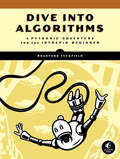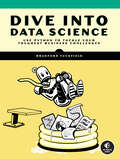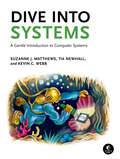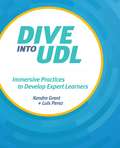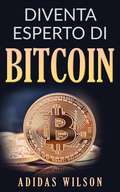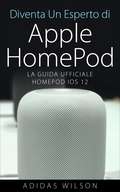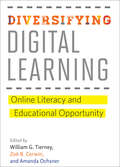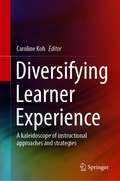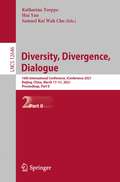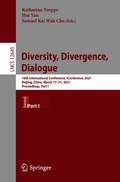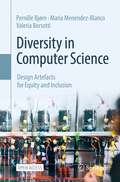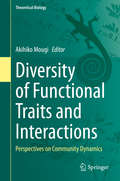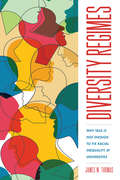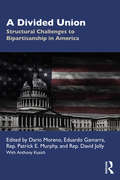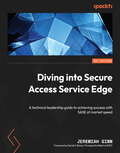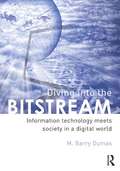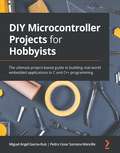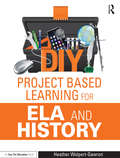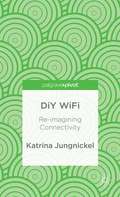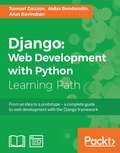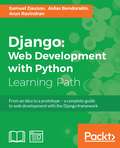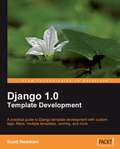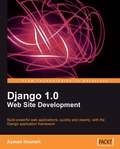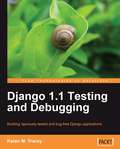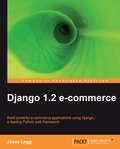- Table View
- List View
Dive Into Algorithms: A Pythonic Adventure for the Intrepid Beginner
by Bradford TuckfieldDive Into Algorithms is a broad introduction to algorithms using the Python Programming Language.Dive Into Algorithms is a wide-ranging, Pythonic tour of many of the world's most interesting algorithms. With little more than a bit of computer programming experience and basic high-school math, you'll explore standard computer science algorithms for searching, sorting, and optimization; human-based algorithms that help us determine how to catch a baseball or eat the right amount at a buffet; and advanced algorithms like ones used in machine learning and artificial intelligence. You'll even explore how ancient Egyptians and Russian peasants used algorithms to multiply numbers, how the ancient Greeks used them to find greatest common divisors, and how Japanese scholars in the age of samurai designed algorithms capable of generating magic squares.You'll explore algorithms that are useful in pure mathematics and learn how mathematical ideas can improve algorithms. You'll learn about an algorithm for generating continued fractions, one for quick calculations of square roots, and another for generating seemingly random sets of numbers.You'll also learn how to: • Use algorithms to debug code, maximize revenue, schedule tasks, and create decision trees • Measure the efficiency and speed of algorithms • Generate Voronoi diagrams for use in various geometric applications • Use algorithms to build a simple chatbot, win at board games, or solve sudoku puzzles • Write code for gradient ascent and descent algorithms that can find the maxima and minima of functions • Use simulated annealing to perform global optimization • Build a decision tree to predict happiness based on a person's characteristicsOnce you've finished this book you'll understand how to code and implement important algorithms as well as how to measure and optimize their performance, all while learning the nitty-gritty details of today's most powerful algorithms.
Dive Into Data Science: Use Python To Tackle Your Toughest Business Challenges
by Bradford TuckfieldLearn how to use data science and Python to solve everyday business problems.Dive into the exciting world of data science with this practical introduction. Packed with essential skills and useful examples, Dive Into Data Science will show you how to obtain, analyze, and visualize data so you can leverage its power to solve common business challenges.With only a basic understanding of Python and high school math, you&’ll be able to effortlessly work through the book and start implementing data science in your day-to-day work. From improving a bike sharing company to extracting data from websites and creating recommendation systems, you&’ll discover how to find and use data-driven solutions to make business decisions.Topics covered include conducting exploratory data analysis, running A/B tests, performing binary classification using logistic regression models, and using machine learning algorithms.You&’ll also learn how to:Forecast consumer demand Optimize marketing campaignsReduce customer attritionPredict website trafficBuild recommendation systemsWith this practical guide at your fingertips, harness the power of programming, mathematical theory, and good old common sense to find data-driven solutions that make a difference. Don&’t wait; dive right in!
Dive Into Systems: A Gentle Introduction to Computer Systems
by Suzanne J. Matthews Tia Newhall Kevin C. WebbDive into Systems is a vivid introduction to computer organization, architecture, and operating systems that is already being used as a classroom textbook at more than 25 universities.This textbook is a crash course in the major hardware and software components of a modern computer system. Designed for use in a wide range of introductory-level computer science classes, it guides readers through the vertical slice of a computer so they can develop an understanding of the machine at various layers of abstraction. Early chapters begin with the basics of the C programming language often used in systems programming. Other topics explore the architecture of modern computers, the inner workings of operating systems, and the assembly languages that translate human-readable instructions into a binary representation that the computer understands. Later chapters explain how to optimize code for various architectures, how to implement parallel computing with shared memory, and how memory management works in multi-core CPUs. Accessible and easy to follow, the book uses images and hands-on exercise to break down complicated topics, including code examples that can be modified and executed.
Dive Into UDL: Immersive Practices to Develop Expert Learners
by Kendra Grant Luis Perez<p>Universal Design for Learning (UDL) is a framework for designing instruction that meets the needs of every learner. This book provides an overview of UDL, showing how to offer flexibility in methods of presentation, student participation and expression to support high achievement for all students, including those with disabilities or limited English proficiency. Dive into UDL shows K-12 educators how to incorporate UDL in their instructional design and engage in continuous professional growth. The book will also appeal to those in coaching positions and to administrators seeking to support their staff. <p>The book: offers three modes of entry to allow educators to "start where they are" in their understanding of UDL and how it applies to their areas of instruction; shows educators how to enhance and transform their instructional practices by applying a UDL lens to analyze and redesign lessons; illustrates how to design accessible materials and use technology to provide more options for learners; and highlights how UDL is foundational to inquiry-based, project-based and constructivist hands-on learning.</p>
Diventa esperto di Bitcoin
by Adidas Wilson Andrea GiampaoliIl Bitcoin è una criptovaluta ed un sistema di pagamento digitale ideato da uno sviluppatore sconosciuto, o da un gruppo di sviluppatori sotto il nome di Satoshi Nakamoto. Venne pubblicato come software open-source nel 2009. Il sistema è peer-to-peer e le transazioni vengono effettuate direttamente tra gli utenti, senza un intermediario. Queste transazioni vengono in seguito verificate dai nodi del network e registrate in un libro contabile pubblico chiamato blockchain. Poiché il sistema funziona senza un database centrale o un amministratore, il Bitcoin viene definito come la prima valuta digitale decentralizzata. Oltre ad essere creato come premio per il mining, il Bitcoin può essere scambiato con altre valute, prodotti e servizi nei mercati legali o nei mercati di contrabbando. Nel Febbraio 2015 oltre 100.000 commercianti e venditori accettavano pagamenti in Bitcoin. Secondo una ricerca dell'Università di Cambridge pubblicata nel 2017, ci sono da 2.9 a 5.8 milioni di utenti che usano un portafoglio di criptovalute, e la maggior parte di essi usano i Bitcoin.
Diventa Un Esperto di Apple HomePod: La Guida Ufficiale HomePod IOS 12
by Adidas WilsonIl nuovo dispositivo HomePod offre un servizio semplice e sorprendente per gli utenti Apple di godersi AirPlay, Apple Music e controllare i dispositivi HomeKit da qualsiasi luogo. HomePod non è stato creato per essere un concorrente di Google Home o Amazon Echo, così come il MacBook Air non era progettato per competere con il netbook. Certo, entrambi condividono un certo numero di caratteristiche . Ad esempio, l'altoparlante HomePod può essere controllato vocalmente e il MacBook Air è compatto e leggero. Tuttavia, HomePod è un assistente domestico da 350 dollari ; molto simile al MacBook, un computer portatile da 200 dollari. Il Fire Phone di Amazon non è stato un successo. Alexa, quindi, ha dovuto vendere molto in modo che Prime potesse restare nella vita di molti utenti. Questo risultò un successo grazie ai prezzi contenuti di Echo. Quando si tratta di HomePod, però, la questione cambia. AirPod è stato progettato per aiutarti a godere la tua musica preferita mentre sei in viaggio, mentre HomePod è stato progettato per ascoltare la tua musica preferita comodamente a casa tua.
Diversifying Digital Learning: Online Literacy and Educational Opportunity (Tech.edu: A Hopkins Series on Education and Technology)
by Edited by William G. Tierney, Zoë B. Corwin, and Amanda OchsnerHow does the digital divide affect the teaching and learning of historically underrepresented students?Many schools and programs in low-income neighborhoods lack access to the technological resources, including equipment and Internet service, that those in middle- and upper-income neighborhoods have at their fingertips. This inequity creates a persistent digital divide—not a simple divide in access to technology per se, but a divide in both formal and informal digital literacy that further marginalizes youths from low-income, minoritized, and first-generation communities.Diversifying Digital Learning outlines the pervasive problems that exist with ensuring digital equity and identifies successful strategies to tackle the issue. Bringing together top scholars to discuss how digital equity in education might become a key goal in American education, this book is structured to provide a framework for understanding how historically underrepresented students most effectively engage with technology—and how institutions may help or hinder students’ ability to develop and capitalize on digital literacies.This book will appeal to readers who are well versed in the diverse uses of social media and technologies, as well as less technologically savvy educators and policy analysts in educational organizations such as schools, afterschool programs, colleges, and universities. Addressing the intersection of digital media, race/ethnicity, and socioeconomic class in a frank manner, the lessons within this compelling work will help educators enable students in grades K–12, as well as in postsecondary institutions, to participate in a rapidly changing world framed by shifting new media technologies.Contributors: Young Whan Choi, Zoë B. Corwin, Christina Evans, Julie Flapan, Joanna Goode, Erica Hodgin, Joseph Kahne, Suneal Kolluri, Lynette Kvasny, David J. Leonard, Jane Margolis, Crystle Martin, Safiya Umoja Noble, Amanda Ochsner, Fay Cobb Payton, Antar A. Tichavakunda, William G. Tierney, S. Craig Watkins
Diversifying Learner Experience: A kaleidoscope of instructional approaches and strategies
by Caroline KohThis book brings together strategies and innovations that educators from diverse educational contexts have conceptualized and implemented to cater to differences in academic ability, as well as in other domains such as psychosocial contexts and developmental needs. The emergence of IT and new technologies have altered the educational landscape and opened a multitude of opportunities for diverse modes of instruction catering to diverse student populations.The book addresses the gap in the literature with evidence-based reports of innovative strategies and approaches that are grounded in educational research. It identifies student differences in terms of academic ability and also, with regard to their cultural and social background, their developmental and psycho-emotional needs. It examines how new technologies are used in instructional approaches and how these innovative strategies diversify learner experiences. The book is a valuable resource to practitioners, researchers and educational administrators.
Diversity, Divergence, Dialogue: 16th International Conference, iConference 2021, Beijing, China, March 17–31, 2021, Proceedings, Part II (Lecture Notes in Computer Science #12646)
by Katharina Toeppe Hui Yan Samuel Kai Wah ChuThis two-volume set LNCS 12645-12646 constitutes the refereed proceedings of the 16th International Conference on Diversity, Divergence, Dialogue, iConference 2021, held in Beijing, China, in March 2021. The 32 full papers and the 59 short papers presented in this two-volume set were carefully reviewed and selected from 225 submissions. They cover topics such as: AI and machine learning; data science; human-computer interaction; social media; digital humanities; education and information literacy; information behavior; information governance and ethics; archives and records; research methods; and institutional management.
Diversity, Divergence, Dialogue: 16th International Conference, iConference 2021, Beijing, China, March 17–31, 2021, Proceedings, Part I (Lecture Notes in Computer Science #12645)
by Katharina Toeppe Hui Yan Samuel Kai Wah ChuThis two-volume set LNCS 12645-12646 constitutes the refereed proceedings of the 16th International Conference on Diversity, Divergence, Dialogue, iConference 2021, held in Beijing, China, in March 2021. The 32 full papers and the 59 short papers presented in this volume were carefully reviewed and selected from 225 submissions. They cover topics such as: AI and machine learning; data science; human-computer interaction; social media; digital humanities; education and information literacy; information behavior; information governance and ethics; archives and records; research methods; and institutional management.
Diversity in Computer Science: Design Artefacts for Equity and Inclusion
by Pernille Bjørn Maria Menendez-Blanco Valeria BorsottiThis is an open access book that covers the complete set of experiences and results of the FemTech.dk research which we have had conducted between 2016-2021 – from initiate idea to societal communication. Diversity in Computer Science: Design Artefacts for Equity and Inclusion presents and documents the principles, results, and learnings behind the research initiative FemTech.dk, which was created in 2016 and continues today as an important part of the Department of Computer Science at the University of Copenhagen’s strategic development for years to come. FemTech.dk was created in 2016 to engage with research within gender and diversity and to explore the role of gender equity as part of digital technology design and development. FemTech.dk considers how and why computer science as a field and profession in Denmark has such a distinct unbalanced gender representation in the 21st century. This book is also the story of how we (the authors) as computer science researchers embarked on a journey to engage with a new research field – equity and gender in computing – about which we had only sporadic knowledge when we began. We refer here to equity and gender in computing as a research field – but in reality, this research field is a multiplicity of entangled paths, concepts, and directions that forms important and critical insights about society, gender, politics, and infrastructures which are published in different venues and often have very different sets of criteria, values, and assumptions. Thus, part of our journey is also to learn and engage with all these different streams of research, concepts, and theoretical approaches and, through these engagements, to identify and develop our own theoretical platform, which has a foundation in our research backgrounds in Human–Computer Interaction broadly – and Interaction Design & Computer Supported Cooperative Work specifically.
Diversity of Functional Traits and Interactions: Perspectives on Community Dynamics (Theoretical Biology)
by Akihiko MougiThis book presents new theoretical perspectives on ecological community dynamics and in so doing casts fresh light on the enduring complexity–stability debate. Real ecological communities do not simply comprise diverse species and interactions, which respectively represented the nodes and links of the classic network theory. Rather, they are characterized by different types of complexity, and this book explains how this diversity of complexity is key to understanding the dynamics of ecological communities. It is shown how various properties in natural communities, such as life history, adaptation, density dependence, sex, interaction types, space, functional traits, and microbial processes, can dramatically increase the complexity in ecological communities. Furthermore, innovative methods are introduced that may be applied to cast light on very complex communities. With each chapter presenting the latest advances and approaches, the book sets the direction for future research on ecological community dynamics. It will be a “must read” for researchers and students in the field of ecology.
Diversity Regimes: Why Talk Is Not Enough to Fix Racial Inequality at Universities (The American Campus)
by James M. ThomasAs a major, public flagship university in the American South, so-called “Diversity University” has struggled to define its commitments to diversity and inclusion, and to put those commitments into practice. In Diversity Regimes, sociologist James M. Thomas draws on more than two years of ethnographic fieldwork at DU to illustrate the conflicts and contingencies between a core set of actors at DU over what diversity is and how it should be accomplished. Thomas’s analysis of this dynamic process uncovers what he calls “diversity regimes”: a complex combination of meanings, practices, and actions that work to institutionalize commitments to diversity, but in doing so obscure, entrench, and even magnify existing racial inequalities. Thomas’s concept of diversity regimes, and his focus on how they are organized and unfold in real time, provides new insights into the social organization of multicultural principles and practices.
A Divided Union: Structural Challenges to Bipartisanship in America
by Dario Moreno, Eduardo Gamarra, Rep. Patrick E. Murphy, and Rep. David JollyA Divided Union delves deep into ten pressing political challenges that former US Representatives Patrick Murphy (D) and David Jolly (R) have identified over their multiple terms in Congress and that continue to plague the American electorate today. In an introduction describing their unique paths to Congress, Murphy and Jolly focus in detail on key institutional barriers they faced in Washington in attempting to do the job voters elected them to do. They introduce us to geographic challenges, demographic change, a polarized media, gerrymandering, the role of money in politics, the structure of primary elections, and several other aspects of political life on Capitol Hill. The core of the book is original analysis by experts who tackle these topics in a manner relevant to both the seasoned political science student as well as the general reader. From the commercials we see on TV to the city council districts in which we live, these concerns shape every facet of our public lives and are distilled here in a careful synthesis of years of experience and research. Contributors include former federal elected officials, political science professors, members of the press, and scholars immersed in their fields of study. While other textbooks may examine similar issues, few have been edited by former members of the U.S. House who have walked the halls of Congress and directly experienced political dysfunction at so many levels – and are willing to address it. A Divided Union is appropriate for all political science students as well as the general public frustrated and alarmed by political gridlock.
Diving into Secure Access Service Edge: A technical leadership guide to achieving success with SASE at market speed
by Jeremiah Ginn David H. BrownImplement Secure Access Service Edge (SASE) for secure network and application communications, exploring SASE services including SD-WAN, ZTF, and more with expert Jeremiah Ginn who helps CxO leaders achieve SASE successKey FeaturesMerge networking and security services into a single architecture to simplify network infrastructureExplore how zero trust network access (ZTNA) restricts access to provide native application segmentationFocus on a native, multitenant cloud architecture that scales dynamically with demandBook DescriptionThe SASE concept was coined by Gartner after seeing a pattern emerge in cloud and SD-WAN projects where full security integration was needed. The market behavior lately has sparked something like a "space race" for all technology manufacturers and cloud service providers to offer a "SASE" solution. The current training available in the market is minimal and manufacturer-oriented, with new services being released every few weeks. Professional architects and engineers trying to implement SASE need to take a manufacturer-neutral approach.This guide provides a foundation for understanding SASE, but it also has a lasting impact because it not only addresses the problems that existed at the time of publication, but also provides a continual learning approach to successfully lead in a market that evolves every few weeks. Technology teams need a tool that provides a model to keep up with new information as it becomes available and stay ahead of market hype.With this book, you'll learn about crucial models for SASE success in designing, building, deploying, and supporting operations to ensure the most positive user experience (UX). In addition to SASE, you'll gain insight into SD-WAN design, DevOps, zero trust, and next-generation technical education methods.What you will learnDevelop a comprehensive understanding of SASE from a market and technical perspectiveUnderstand SASE services and components included in SASE solutionsMove logically from prescriptive design to policy-based design and orchestrationUnderstand standard SASE use cases and how to integrate future componentsConvert from a legacy network design model to a secure DevOps model for future projectsUse a functional design overlay to eliminate inter-service competition for the control plane of the SASE serviceWho this book is forThis book is for technology and security leaders and specifically for any CTO, CSO, CISO, or CIO looking for an executive approach to SASE for their organization. Anyone implementing SD-WAN, SASE, and SASE services for cloud, network, and security infrastructure will also find this book helpful.
Diving Into the Bitstream: Information Technology Meets Society in a Digital World
by Barry M. DumasNationwide, and indeed worldwide, there has been a growing awareness of the importance of access to information. Accordingly, information technology (IT), broadly defined and its role beyond the internal workings of businesses has leapt into the social consciousness. Diving into the Bitstream distinguishes itself by weaving together the concepts and conditions of IT. What distinguishes these trends is their focus on the impacts of IT on societies, and the responsibilities of IT's creators and users. The author pulls together important, often complex issues in the relationships among information, information technologies, and societal constructs. The text explores a synopsis of these issues that are foundations for further consideration.
DIY Microcontroller Projects for Hobbyists: The ultimate project-based guide to building real-world embedded applications in C and C++ programming
by Miguel Angel Garcia-Ruiz Pedro Cesar MancillaA practical guide to building PIC and STM32 microcontroller board applications with C and C++ programmingKey FeaturesDiscover how to apply microcontroller boards in real life to create interesting IoT projectsCreate innovative solutions to help improve the lives of people affected by the COVID-19 pandemicDesign, build, program, and test microcontroller-based projects with the C and C++ programming languageBook DescriptionWe live in a world surrounded by electronic devices, and microcontrollers are the brains of these devices. Microcontroller programming is an essential skill in the era of the Internet of Things (IoT), and this book helps you to get up to speed with it by working through projects for designing and developing embedded apps with microcontroller boards. DIY Microcontroller Projects for Hobbyists are filled with microcontroller programming C and C++ language constructs. You'll discover how to use the Blue Pill (containing a type of STM32 microcontroller) and Curiosity Nano (containing a type of PIC microcontroller) boards for executing your projects as PIC is a beginner-level board and STM-32 is an ARM Cortex-based board. Later, you'll explore the fundamentals of digital electronics and microcontroller board programming. The book uses examples such as measuring humidity and temperature in an environment to help you gain hands-on project experience. You'll build on your knowledge as you create IoT projects by applying more complex sensors. Finally, you'll find out how to plan for a microcontroller-based project and troubleshoot it. By the end of this book, you'll have developed a firm foundation in electronics and practical PIC and STM32 microcontroller programming and interfacing, adding valuable skills to your professional portfolio.What you will learnGet to grips with the basics of digital and analog electronicsDesign, build, program, and test a microcontroller-based systemUnderstand the importance and applications of STM32 and PIC microcontrollersDiscover how to connect sensors to microcontroller boardsFind out how to obtain sensor data via codingUse microcontroller boards in real life and practical projects Who this book is forThis STM32 PIC microcontroller book is for students, hobbyists, and engineers who want to explore the world of embedded systems and microcontroller programming. Beginners, as well as more experienced users of digital electronics and microcontrollers, will also find this book useful. Basic knowledge of digital circuits and C and C++ programming will be helpful but not necessary.
DIY Project Based Learning for ELA and History
by Heather Wolpert-GawronAre you interested in using Project Based Learning to revamp your lessons, but aren’t sure how to get started? In DIY Project Based Learning in ELA and History, award-winning teacher and Edutopia blogger Heather Wolpert-Gawron makes it fun and easy! Project Based Learning encourages students and teachers alike to abandon their dusty textbooks, and instead embrace a form of curriculum design focused on student engagement, innovation, and creative problem-solving. A leading name in this field, Heather Wolpert-Gawron shares some of her most popular units for ELA and Social Studies in this exciting new collection. This book is an essential resource for teachers looking to: Create their own Project Based Learning units. Engage student in their education by grounding lessons in real-world problems and encouraging them to develop creative solutions. Incorporate role-playing into everyday learning. Develop real-world lessons to get students to understand the life-long relevance of what they are learning. Assess multiple skills and subject areas in an integrated way. Collaborate with teachers across subject areas. Test authentic skills and set authentic goals for their students to grow as individuals. Part I of the book features six full units, complete with student samples, targeted rubrics, a checklist to keep students on track, and even "Homework Hints." Part II is a mix-and-match section of tools you can use to create your own PBL-aligned lessons. The tools are available as eResources on our website, http://www.routledge.com/books/details/9781138891623, so you can print and use them in your classroom immediately.
Diy Wifi
by Katrina JungnickelWho makes WiFi? Why do different makers matter? What do barbeques and backyards have to do with the internet? This book explores how WiFi is made from the ground up, or in this case from the backyard out. Forged around barbeques, made of found, adapted and off-the-shelf materials and installed in ordinary domestic spaces, this book documents the collective work of individuals committed to making 'Ournet not the internet'. Drawing on rich ethnographic material, Jungnickel's research on community WiFi networking provides an overdue account of the innovative digital cultures and practices of ordinary people making extra-ordinary things. What make-do methods, mods and tales of resourceful ingenuity permit is another way of seeing how technologies come into being. It brings to life an Australian version of WiFi, enriching global studies of wireless technology by signalling the potential of comparative studies. Critically, the book presents the first sustained study of homebrew high-tech backyard technologists who imbue a DIY ethos but do not do it alone - they Do-It-Together (DIT). This timely critique of collective DIT innovation in an increasingly networked society will be of interest to scholars and practitioners of maker culture.
Django: Web Development with Python
by Samuel Dauzon Aidas Bendoraitis Arun RavindranFrom an idea to a prototype - a complete guide for web development with the Django framework About This Book * Explore the best practices to develop applications of a superior quality with Django framework * Unravel the common problems of web development in Django * This course teaches you major Django functions and will help you improve your skills by developing models, forms, views, and templates * Experience the challenges of working on an end-to-end social network project Who This Book Is For Web developers who want to use modern Python-based web frameworks like Django to build powerful web applications. The course is mostly self-contained and introduces web development with Python to a reader who is familiar with web development concepts and can help him become an expert in this trade. It's intended for all levels of web developers, both students and practitioners from novice to experts. What You Will Learn * Use Django models to store information in the database and generate queries to access a database across models * Quickly develop web pages to create, read, update, and delete data from the model using class-based views * Generate very maintainable forms with Django * Import data from local sources and external web services as well as exporting your data to third parties * Deep dive into various aspects of Django from models and views to testing and deployment * Familiarize yourself with the various nuances of web development such as browser attacks and databases In Detail Data science is hot right now, and the need for multitalented developers is greater than ever before. A basic grounding in building apps with a framework as minimalistic, powerful, and easy-to-learn as Django will be a useful skill to launch your career as an entrepreneur or web developer. Django is a web framework that was designed to strike a balance between rapid web development and high performance. This course will take you on a journey to become an efficient web developer thoroughly understanding the key concepts of Django framework. This learning path is divided into three modules. The course begins with basic concepts of the Django framework. The first module, Django Essentials, is like a practical guide, filled with many real-world examples to build highly effective Django web application. After getting familiar with core concepts of Django, it's time to practice your learning from the first module with the help of over 90 recipes available in this module. In the second module, Web Development with Django Cookbook, you'll learn varying complexities to help you create multilingual, responsive, and scalable websites with Django. By the end of this module, you will have a good understanding of the new features added to Django 1.8 and be an expert at web development processes.The next step is to discover the latest best practices and idioms in this rapidly evolving Django framework. This is what you'll be learning in our third module, Django Design Patterns and Best Practices. This module will teach you common design patterns to develop better Django code. By the end of the module, you will be able to leverage the Django framework to develop a fully functional web application with minimal effort. Style and approach This course includes all the resources that will help you jump into the web development field with Django and learn how to make scalable and robust web applications. The aim is to create a smooth learning path that will teach you how to get started with the powerful Django framework and perform various web development techniques in depth. Through this comprehensive course, you'll learn web development with Django from scratch to finish!
Django: Web Development with Python
by Samuel Dauzon Aidas Bendoraitis Arun Ravindran<P><P>About This Book <P><P>Explore the best practices to develop applications of a superior quality with Django framework <P><P>Unravel the common problems of web development in Django <P><P>This course teaches you major Django functions and will help you improve your skills by developing models, forms, views, and templates <P><P>Experience the challenges of working on an end-to-end social network project <P><P>Who This Book Is For <P><P>Web developers who want to use modern Python-based web frameworks like Django to build powerful web applications. The course is mostly self-contained and introduces web development with Python to a reader who is familiar with web development concepts and can help him become an expert in this trade. It's intended for all levels of web developers, both students and practitioners from novice to experts. <P><P>What You Will Learn <P><P>Use Django models to store information in a database and generate queries to access a database across models <P><P>Quickly develop web pages to create, read, update, and delete data from the model using class-based views <P><P>Generate very maintainable forms with Django <P><P>Import data from local sources and external web services, as well as exporting your data to third parties <P><P>Deep dive into various aspects of Django, from models and views to testing and deployment <P><P>Familiarize yourself with the various nuances of web development such as browser attacks and databases <P><P>In Detail <P><P>Data science is hot right now, and the need for multitalented developers is greater than ever before. A basic grounding in building apps with a framework as minimalistic, powerful, and easy-to-learn as Django will be a useful skill when launching your career as an entrepreneur or web developer. <P><P>Django is a web framework that was designed to strike a balance between rapid web development and high performance. This course will take you on a journey to become an efficient web developer who thoroughly understands the key concepts of the Django framework. <P><P>The first module, Django Essentials, is a practical guide, filled with many real-world examples to build highly effective Django web applications. In the second module, Web Development with Django Cookbook, you'll learn varying complexities to help you create multilingual, responsive, and scalable websites with Django. The next step is to discover the latest best practices and idioms in the rapidly evolving Django framework. This is what you'll be learning in our third module, Django Design Patterns and Best Practices. By the end of the module, you will be able to leverage the Django framework to develop a fully functional web application with minimal effort.
Django 1.0 Template Development
by Scott NewmanThis book is designed for readers who learn by doing and employs many examples and screenshots to let the reader dig in and start coding. This book isn't designed to be a reference; instead it has a practical, example-driven approach that teaches you by following along with the examples in the chapters. When you have completed this book, you will fully understand how the template system works, how to extend it when you have specialized needs, and how to optimize the performance and usability of your content. This book is for web developers and template authors who want to fully understand and utilize the Django template system. The reader should have completed the introductory tutorials on the Django project's website and some experience with the framework will be very helpful. Basic knowledge of Python and HTML is assumed.
Django 1.0 Website Development
by Ayman HouriehThe simple and clear approach is ideal for beginners to Django. Packed with examples and screenshots, this book will help you learn the features of Django 1.0 and help you build a dynamic website using those features.This book is for web developers who want to learn to build a complete site with Web 2.0 features, using the power of a proven and popular development system, Django, but do not necessarily want to learn how the complete framework functions in order to do this. Basic knowledge of Python development is required for this book, but no knowledge of Django is expected.
Django 1.1 Testing and Debugging
by Karen M. TraceyThis book teaches by example. It walks in detail through development of a sample application, illustrating each step via complete working code and either screenshots or console snippets. The cumbersome and time consuming task of debugging will be a cake walk with this book. If you are a Django application developer who wants to create robust applications quickly that work well and are easy to maintain in the long term, this book is for you. This book is the right pick if you want to be smartly tutored to make best use of Django's rich testing and debugging support and make testing an effortless task. Basic knowledge of Python, Django, and the overall structure of a database-driven web application is assumed. However, the code samples are fully explained so that even beginners who are new to the area can learn a great deal from this book.
Django 1.2 e-commerce
by Jesse LeggPacked with code examples and configuration hints for related web technologies, the book helps you add a new feature to your store in each chapter. It also provides additional documentation and comments for popular web APIs. If you are a Django developer and wish to build an e-commerce application, then this book is for you. You need to be familiar with the basics of developing in Django.
